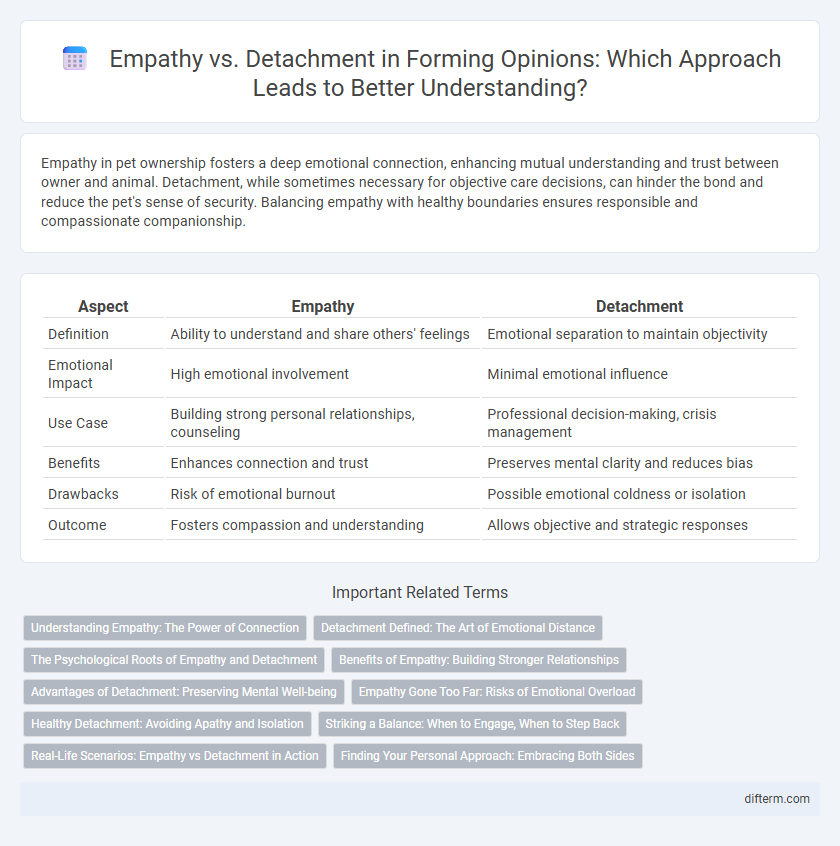Empathy in pet ownership fosters a deep emotional connection, enhancing mutual understanding and trust between owner and animal. Detachment, while sometimes necessary for objective care decisions, can hinder the bond and reduce the pet's sense of security. Balancing empathy with healthy boundaries ensures responsible and compassionate companionship.
Table of Comparison
| Aspect | Empathy | Detachment |
|---|---|---|
| Definition | Ability to understand and share others' feelings | Emotional separation to maintain objectivity |
| Emotional Impact | High emotional involvement | Minimal emotional influence |
| Use Case | Building strong personal relationships, counseling | Professional decision-making, crisis management |
| Benefits | Enhances connection and trust | Preserves mental clarity and reduces bias |
| Drawbacks | Risk of emotional burnout | Possible emotional coldness or isolation |
| Outcome | Fosters compassion and understanding | Allows objective and strategic responses |
Understanding Empathy: The Power of Connection
Understanding empathy unlocks the profound power of human connection by allowing individuals to genuinely share and resonate with others' feelings and experiences. This emotional insight fosters deeper relationships and promotes compassion, transforming interactions beyond superficial exchanges. Empathy serves as a crucial bridge between detachment and engagement, enabling meaningful understanding without losing personal boundaries.
Detachment Defined: The Art of Emotional Distance
Detachment, defined as the disciplined practice of maintaining emotional distance, enables clearer decision-making by minimizing personal biases and emotional entanglement. This emotional boundary fosters resilience in high-stress environments, promoting objective analysis and balanced judgment. Cultivating detachment does not imply apathy but rather a conscious effort to observe situations with clarity and composure.
The Psychological Roots of Empathy and Detachment
Empathy originates in mirror neurons and early childhood bonding, enabling individuals to resonate with others' emotions, while detachment often stems from adaptive defense mechanisms developed to manage stress or trauma. Neural pathways involving the anterior insula and anterior cingulate cortex facilitate empathetic responses, whereas detachment engages the prefrontal cortex to regulate emotional distancing. Understanding these psychological roots highlights the balance between emotional connection and protective disengagement as essential for mental health resilience.
Benefits of Empathy: Building Stronger Relationships
Empathy fosters deeper connections by allowing individuals to understand and share the feelings of others, which enhances trust and communication. It promotes emotional support and collaboration, essential for both personal and professional relationships. Empathy-driven interactions create a foundation for mutual respect, reducing conflicts and encouraging a more compassionate environment.
Advantages of Detachment: Preserving Mental Well-being
Detachment allows individuals to maintain emotional boundaries, reducing the risk of burnout and compassion fatigue common in highly empathetic roles. It promotes clearer judgment and objectivity by minimizing emotional bias, which can enhance decision-making and problem-solving abilities. Mental well-being is preserved through detachment as it prevents overwhelming emotional involvement, fostering resilience and long-term psychological stability.
Empathy Gone Too Far: Risks of Emotional Overload
Empathy gone too far leads to emotional overload, impairing decision-making and mental well-being. Excessive emotional involvement can cause burnout, compassion fatigue, and blurred personal boundaries. Balancing empathy with healthy detachment ensures sustained emotional resilience and clear-headed judgment.
Healthy Detachment: Avoiding Apathy and Isolation
Healthy detachment preserves emotional boundaries while fostering self-awareness, preventing the pitfalls of apathy and social isolation. By balancing empathy with mindful distance, individuals maintain emotional resilience and promote healthier relationships. This approach encourages mental well-being through deliberate engagement rather than emotional overload or numbness.
Striking a Balance: When to Engage, When to Step Back
Striking the right balance between empathy and detachment is essential for effective decision-making and emotional well-being. Engaging with empathy fosters deeper connections and understanding, while strategic detachment prevents emotional burnout and maintains objectivity. Recognizing when to immerse oneself in others' experiences and when to step back ensures resilience and compassionate yet clear-headed interactions.
Real-Life Scenarios: Empathy vs Detachment in Action
Empathy enables individuals to connect deeply in real-life scenarios, fostering trust and effective communication, especially in caregiving, counseling, and conflict resolution settings. Detachment, however, helps professionals like emergency responders and analysts maintain objectivity and make critical decisions without emotional bias. Balancing empathy and detachment is crucial for optimal outcomes in dynamic, emotionally charged environments.
Finding Your Personal Approach: Embracing Both Sides
Balancing empathy and detachment is essential for emotional well-being, as it allows individuals to connect deeply with others while maintaining necessary boundaries. Embracing both sides fosters resilience, preventing emotional burnout by selectively engaging with feelings without becoming overwhelmed. Finding a personal approach means tailoring this balance to one's unique experiences, ensuring compassionate understanding coexists with healthy self-preservation.
empathy vs detachment Infographic

 difterm.com
difterm.com